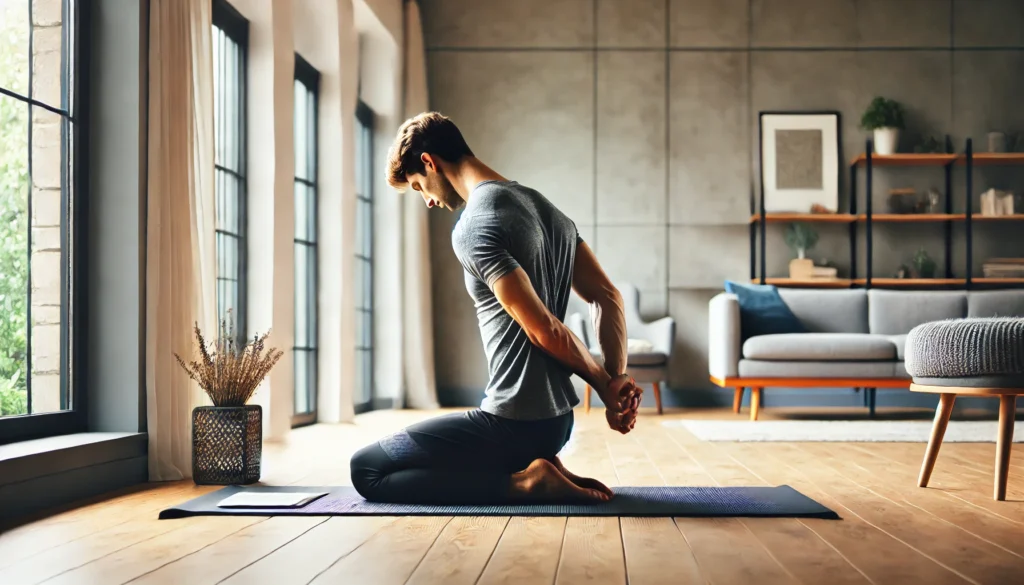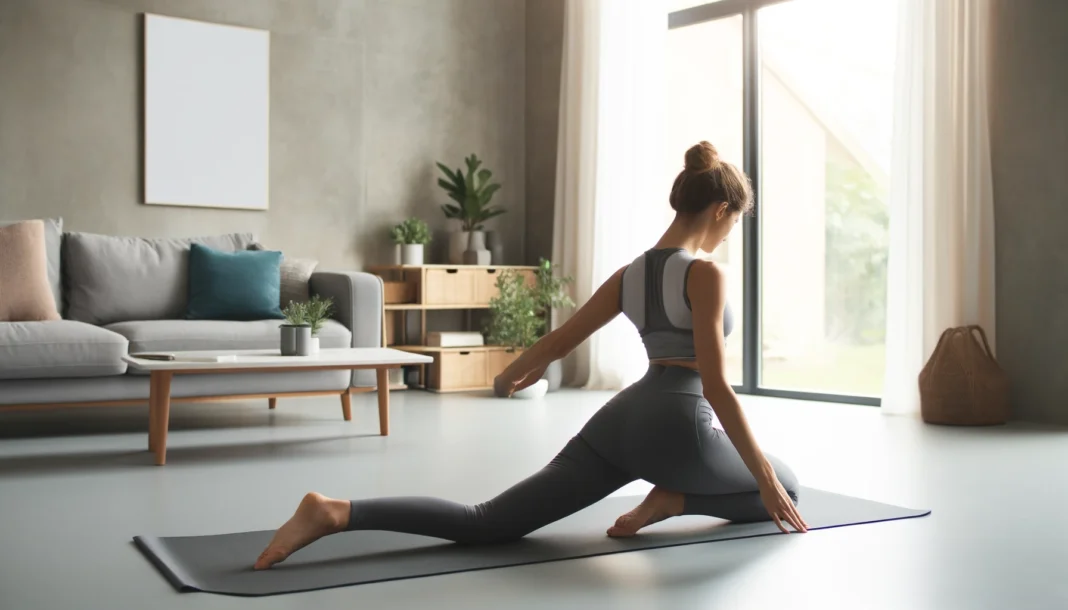Introduction: Understanding the Importance of Lower Back Health
Lower back pain is one of the most prevalent musculoskeletal complaints worldwide, affecting people of all ages and activity levels. Whether caused by prolonged sitting, poor posture, heavy lifting, or general muscle imbalances, lower back discomfort can hinder mobility and reduce overall quality of life. Engaging in targeted lower back stretches and strengthening exercises can alleviate pain, improve flexibility, and prevent future injuries. This comprehensive guide explores the best strategies for maintaining lower back health, offering a scientifically backed approach to achieving lasting relief and functional strength.
You may also like: The Ultimate Bodyweight Workout Routine for Full-Body Strength and Performance
The Anatomy of the Lower Back and Its Role in Movement
The lower back, or lumbar region, consists of five vertebrae that support the upper body and facilitate movement. This area also includes muscles such as the erector spinae, quadratus lumborum, multifidus, and psoas, all of which contribute to core stability and spinal alignment. When these muscles become weak or tight, they increase strain on the lumbar spine, leading to pain and dysfunction. Understanding the role of each muscle group is crucial in selecting effective lower back exercises and stretches for maintaining mobility and strength.
The Benefits of Lower Back Stretches
Stretching the lower back offers numerous benefits beyond immediate relief from tightness. Regularly performing lower back stretching exercises improves blood circulation, enhances range of motion, and reduces stiffness caused by prolonged inactivity. Additionally, targeted back stretches for lower back pain can help alleviate tension in surrounding muscles, such as the hamstrings and hip flexors, which often contribute to lower back discomfort.
Best Stretches for Lower Back Pain
- Child’s Pose – This yoga-inspired stretch gently elongates the lower back, relieving tension in the spine and hips.
- Knee-to-Chest Stretch – Bringing the knees toward the chest helps decompress the lumbar spine and loosen tight lower back muscles.
- Cat-Cow Stretch – A dynamic movement that promotes spinal flexibility and encourages better posture.
- Seated Forward Fold – This stretch targets both the lower back and hamstrings, improving overall mobility.
- Pelvic Tilts – Engaging the core while tilting the pelvis helps to strengthen the lower back and alleviate pain.
Strengthening the Lower Back: Key Exercises for Stability
While stretching is essential for flexibility, lower back strengthening exercises are equally important for building resilience and preventing injury. Strengthening the muscles supporting the lumbar spine enhances posture, reduces strain, and promotes overall spinal health.

Effective Exercises to Strengthen the Lower Back
- Bird-Dog Exercise – This core stabilization movement enhances balance and strengthens the lower back without excessive strain.
- Superman Pose – Engages the erector spinae muscles to build strength and endurance in the lower back.
- Glute Bridges – Strengthens the lower back, glutes, and hamstrings, promoting pelvic stability.
- Plank Variations – A strong core reduces pressure on the lower back, making planks an essential component of a back-strengthening routine.
- Dead Bug Exercise – Encourages controlled movement while engaging the deep core muscles, reducing the likelihood of lower back pain.
Lower Back Workouts for Long-Term Pain Management
A well-structured lower back workout routine incorporates both stretching and strengthening exercises. Consistently performing these exercises improves flexibility, reduces pain, and supports overall spinal health. A sample weekly lower back workout plan might include:
- Day 1: Flexibility Focus – Gentle lower back stretches and mobility drills
- Day 2: Core Engagement – Strengthening exercises targeting the lumbar region
- Day 3: Active Recovery – Yoga or low-impact movements promoting relaxation
- Day 4: Strength Development – Weighted or resistance-based exercises for back muscles
- Day 5: Functional Training – Movements that mimic daily activities to enhance overall stability
How to Loosen Tight Lower Back Muscles Effectively
Chronic lower back tightness often stems from prolonged sitting, poor posture, or insufficient movement. To effectively loosen tight lower back muscles, individuals should:
- Incorporate Daily Stretching – Regularly performing back stretches for lower back pain can improve mobility and reduce discomfort.
- Use Heat and Cold Therapy – Applying heat to tight muscles or using ice to reduce inflammation can aid in recovery.
- Maintain an Active Lifestyle – Consistent movement prevents stiffness and promotes circulation.
- Practice Proper Posture – Aligning the spine correctly reduces strain on the lower back muscles.
- Engage in Myofascial Release – Foam rolling and massage therapy can help relieve tension in the lower back.
Lower Back Physiotherapy Exercises for Pain Management
Physical therapy plays a crucial role in rehabilitating lower back injuries and chronic pain. Lower back physiotherapy exercises for pain typically focus on gentle movements that promote stability and reduce discomfort. Some commonly prescribed exercises include:
- Lumbar Extensions – Helps restore natural spinal curvature and relieve compression.
- Pelvic Clocks – Encourages controlled movement and enhances core coordination.
- Partial Crunches – Strengthens the abdominals without placing excessive strain on the lower back.
- Wall Sits – Builds endurance in the lower body while promoting postural awareness.

Frequently Asked Questions (FAQ) on Lower Back Stretches and Strengthening Exercises
1. What are some of the best stretches for lower back pain relief?
The best stretches for lower back pain relief include a combination of static and dynamic movements that promote flexibility and mobility. Gentle yoga poses such as the child’s pose and cat-cow stretch help elongate the spine and relieve tension. Additionally, incorporating lower back stretching exercises like the seated spinal twist and the knee-to-chest stretch can improve circulation and release tightness in the lumbar region. These stretches for lower back pain should be performed consistently, holding each position for 20 to 30 seconds while breathing deeply. Regular practice can significantly reduce discomfort and prevent future episodes of lower back pain.
2. How can I strengthen my lower back muscles to prevent pain and injury?
Strengthening the lower back muscles is essential for maintaining proper posture and preventing injuries. Exercises to strengthen the lower back, such as bridges, superman holds, and bird-dogs, target the muscles responsible for spinal support. Lower back strengthening exercises also include deadlifts and Romanian deadlifts, which engage the erector spinae while enhancing overall core stability. Performing these movements two to three times per week helps build endurance and resilience in the lower back. By combining strength training with lower back stretches, individuals can create a balanced routine that promotes both flexibility and strength.
3. What are some effective lower back physiotherapy exercises for pain management?
Lower back physiotherapy exercises for pain relief focus on controlled, low-impact movements designed to improve mobility without straining the spine. Pelvic tilts, McKenzie extensions, and wall sits are commonly recommended exercises for lumbosacral pain that help activate stabilizing muscles while reducing stiffness. Back stretches for lower back pain, such as the knee-to-chest stretch and prone press-ups, also aid in decompressing the spine and alleviating discomfort. Physiotherapists often integrate core stabilization exercises, including planks and dead bugs, to reinforce the lumbar region. These exercises should be performed with proper technique to ensure safety and effectiveness.
4. How do I loosen tight lower back muscles after prolonged sitting?
Prolonged sitting can lead to tightness in the lower back, necessitating targeted stretching exercises for lower back pain relief. Movements such as the standing forward bend, seated spinal twist, and hip flexor stretches help counteract the effects of extended sitting. Foam rolling can also be beneficial in releasing tension in the lower back muscles and adjacent areas. Lower back stretching exercises like the sphinx stretch and cobra pose promote spinal extension and relieve compression. Incorporating movement throughout the day and maintaining an ergonomic workstation setup further helps in preventing chronic tightness.
5. How can I incorporate lower back workouts into my fitness routine?
A well-rounded fitness routine should include lower back workouts that focus on both strength and flexibility. Compound exercises like deadlifts, good mornings, and back extensions are effective for building lower back strength. Bodyweight exercises such as glute bridges and superman holds also engage the lower back without the need for equipment. Stretching exercises for lower back pain should complement strength training by improving range of motion and preventing stiffness. A balanced regimen of strengthening and stretching ensures the lower back remains strong and resilient against strain and injury.
6. What are some ways to stretch my back safely without aggravating pain?
Stretching the back safely requires proper technique and mindfulness of any existing discomfort. The best stretches for lower back pain include movements that gently lengthen the spine, such as the cat-cow stretch, child’s pose, and knee-to-chest stretch. It is important to move slowly, avoiding any bouncing or jerky movements that can exacerbate pain. Holding each stretch for at least 20 seconds allows the muscles to relax and elongate effectively. If pain worsens during stretching, it is advisable to modify the movement or consult a healthcare professional.
7. How can I strengthen the lower back and hips for improved stability?
Strengthening the lower back and hips involves performing exercises that target both muscle groups simultaneously. Hip thrusts, Romanian deadlifts, and kettlebell swings engage the posterior chain, improving overall stability. Exercises like bird-dogs and single-leg deadlifts enhance coordination and balance, reducing the risk of lower back strain. Lower back strengthening exercises, including prone back extensions and reverse hypers, build endurance in the lumbar region. Combining strength work with lower back stretching exercises ensures optimal mobility and function.
8. What is the role of core strength in lower back health?
Core strength plays a critical role in supporting the lower back and reducing strain on the spine. Weak core muscles can contribute to poor posture and increased stress on the lower back. Exercises such as planks, dead bugs, and abdominal bracing reinforce core stability and enhance spinal alignment. Engaging the deep core muscles during lower back exercises ensures proper form and minimizes injury risk. Strengthening both the core and lower back creates a more resilient musculoskeletal system, allowing for improved performance and reduced pain.
9. How often should I perform lower back stretching exercises for optimal results?
Lower back stretching exercises should be performed consistently to maintain flexibility and prevent tightness. Ideally, stretching should be done at least five times per week, with each stretch held for 20 to 30 seconds. Incorporating stretches for lower back pain relief into a daily routine is beneficial for individuals with chronic discomfort. Stretching before and after workouts ensures muscle elasticity and reduces stiffness. Regular practice enhances mobility, allowing for better movement patterns and reduced lower back strain.
10. Can lifestyle changes help in managing lower back pain?
Lifestyle modifications play a significant role in alleviating and preventing lower back pain. Maintaining an active lifestyle with regular lower back workouts and stretching routines helps in keeping muscles flexible and strong. Ergonomic adjustments, such as using a supportive chair and practicing good posture, minimize strain during prolonged sitting. Incorporating activities like swimming and yoga promotes spinal mobility and reduces lower back stress. Additionally, maintaining a healthy weight and proper hydration supports overall spinal health, contributing to long-term pain management.

Conclusion: Creating a Sustainable Lower Back Health Routine
Achieving and maintaining lower back health requires a multifaceted approach that includes stretching, strengthening, and proper lifestyle habits. By incorporating lower back stretches, strengthening exercises, and physiotherapy techniques, individuals can effectively manage pain, improve flexibility, and prevent future injuries. Consistency and mindful movement are key to fostering long-term spinal health and overall well-being.
lower back pain relief, spinal flexibility, core strengthening, lumbar support, yoga for back pain, best back workouts, posture correction, chronic back pain, mobility exercises, injury prevention, functional fitness, strength training, rehabilitation exercises, ergonomic health, active lifestyle, back pain therapy, self-care strategies, wellness and fitness, spinal rehabilitation, home workout routines.
Further Reading:
Back exercises in 15 minutes a day
How to strengthen the lower back
Important Note: The content provided by HealthXWire is for informational purposes only and should not be construed as medical advice, diagnosis, or treatment. While we strive for accuracy, the information presented on this site may not reflect the most current research or medical guidelines. Always seek the advice of your physician or other qualified health provider with any questions you may have regarding a medical condition. HealthXWire does not endorse, recommend, or guarantee the efficacy of any products, services, or treatments mentioned on this site. Users should not disregard professional medical advice or delay seeking it because of something they have read on HealthXWire. HealthXWire is not liable for any damages, loss, or injury arising from reliance on the information provided herein.



